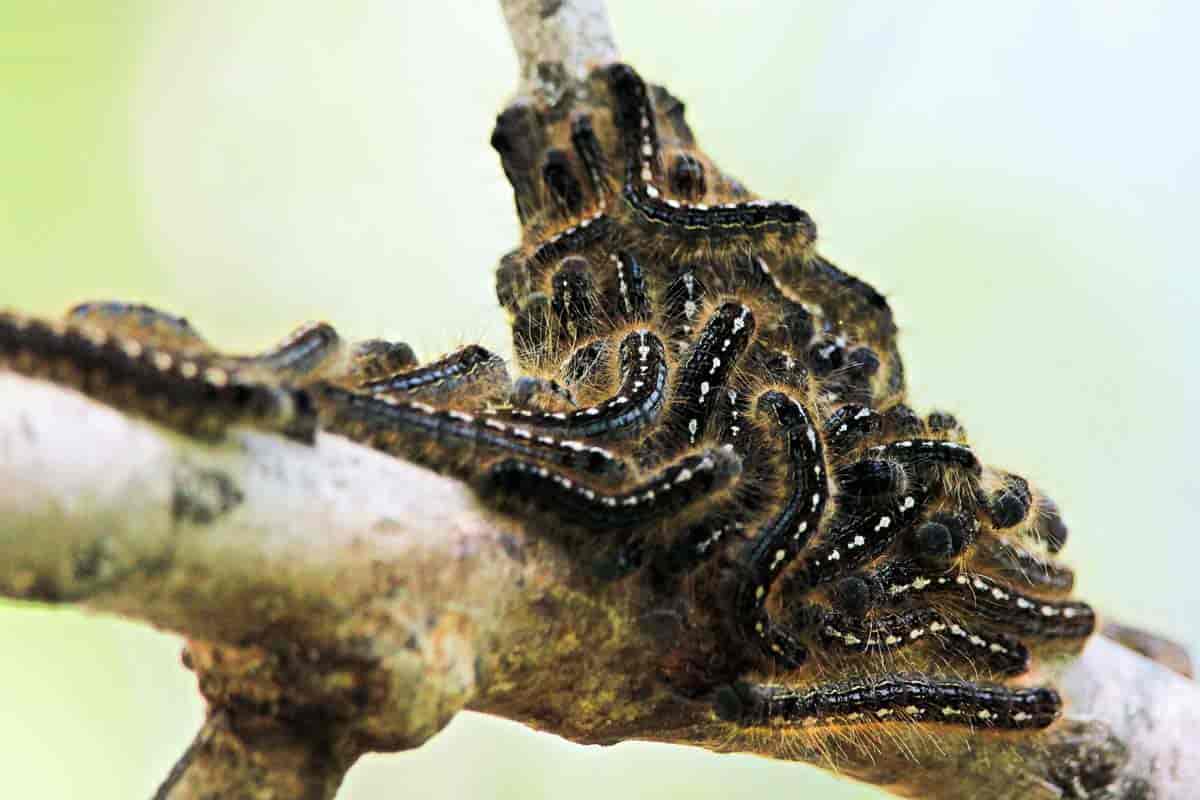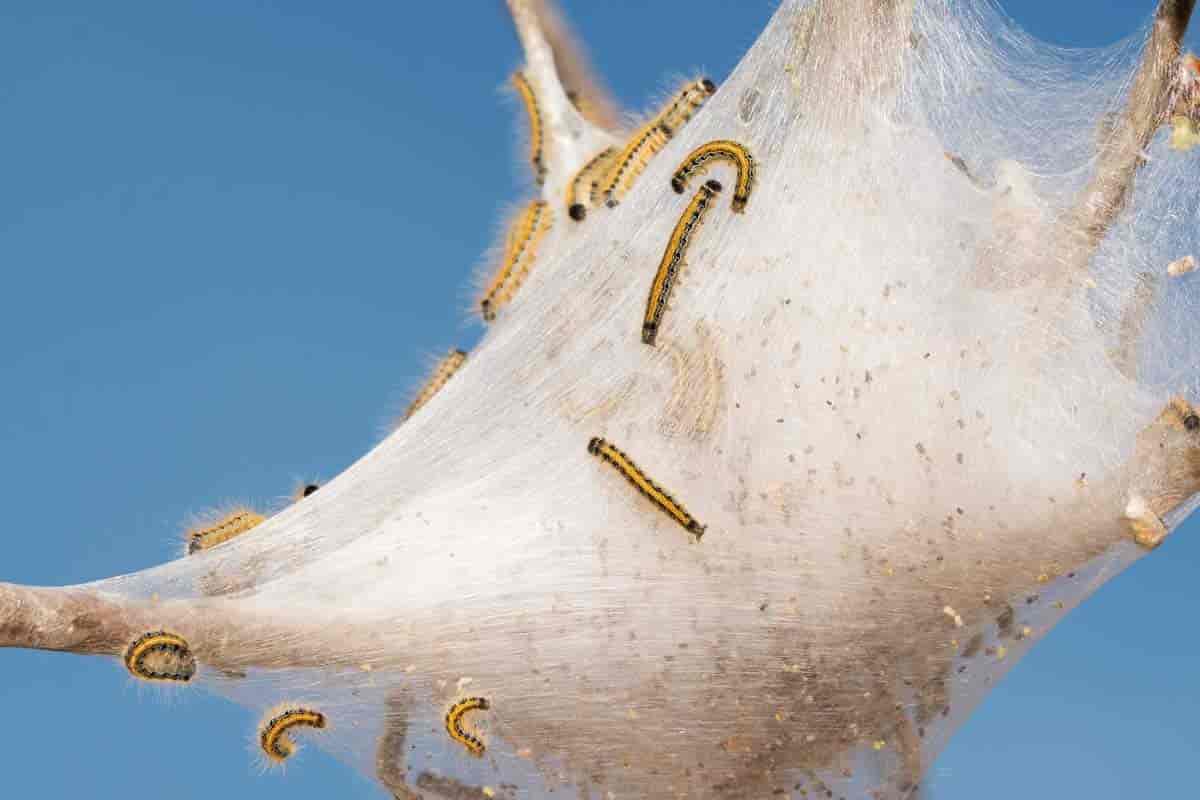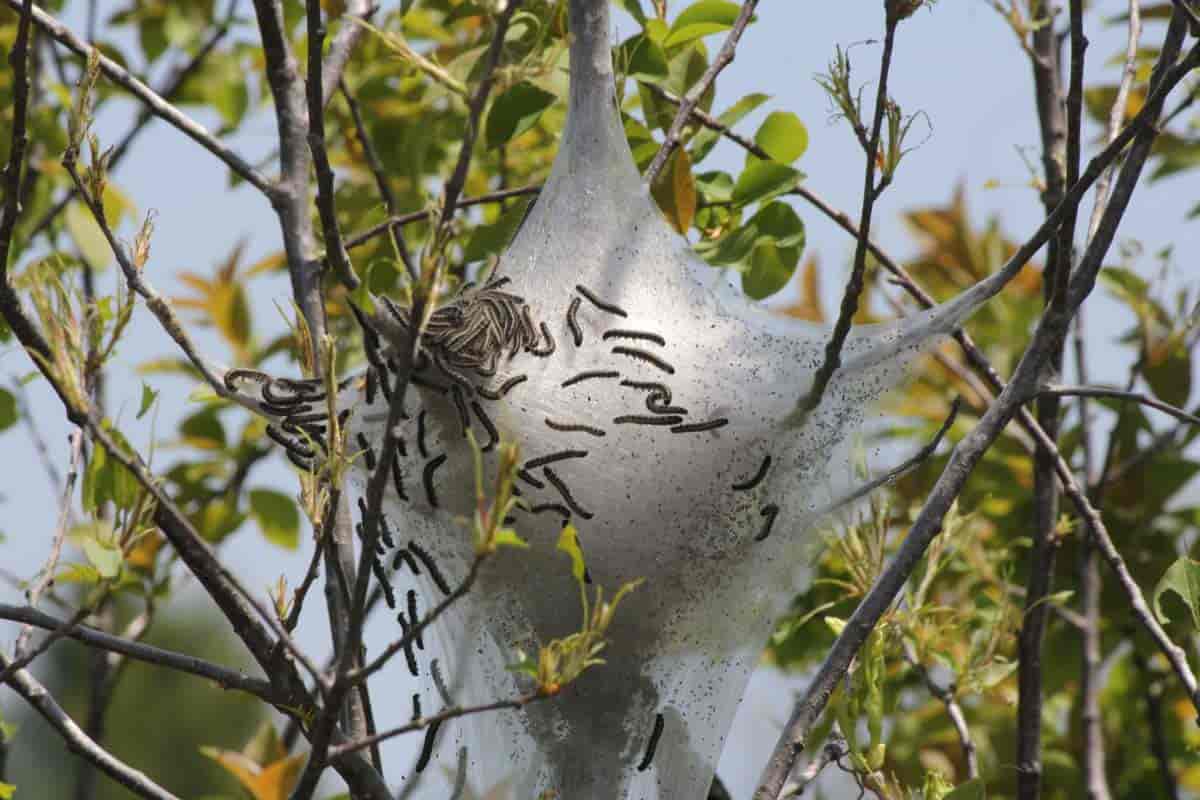The tent caterpillar is a medium-sized moth larva that occurs in great profusion around the world.
All-in-all, there are 26 species. Six of them are native to North America.
colorful tent caterpillar species
These abundant, sociable creatures are usually thought of as pests because they can strip a small tree or host plant of its leaves very quickly.
Even so, they are quite interesting to study.
In this article, we describe three very common types of North American tent caterpillar and share advice on managing and caterpillar control.
What Do Tent Caterpillars Look Like?
It’s easy to recognize these insects because they are:
- Quite colorful
- Active during the daytime
- Tend to congregate in large silken tents in the branches of trees
The nests vary in appearance from one species to another. Some are community tents where large groups of caterpillars live and eat.
Some species build individual tents in a serial manner as they grow.
What Are The Most Common Species In The United States?
The western, eastern and forest tent caterpillars are typically seen in the US.
- Western – (Malacosoma californicum) (Lepidoptera: Lasiocampidae)- found throughout the western US and western Canada
- Eastern – (Malacosoma americanum) (Fabricius) (Lepidoptera: Lasiocampidae) – resides along the east coasts of the US and Canada
- Forest – (Malacosoma disstria) (Lepidoptera: Lasiocampidae) – rugged and adaptable thrives throughout the US and Canada
Throughout North America, there are variations on these three species, but they all look quite a bit alike and have similar habits and life cycles.
Western and Eastern caterpillar species usually begin to appear in early spring.
The adult insects are a type of snout moth, and the larvae appear in large groups within conspicuous white tents built in tree trunk crotches.
Apple and cherry trees are favorites.
Forest caterpillars do not spin webs. Instead, the caterpillars leave a trail of webbing as they crawl along.
This webbing does not make a functioning tent, but it is very conspicuous and unsightly and can cover an entire tree.
When feeding, Forest Caterpillars scatter over a tree. When at rest, they congregate in a cluster.
 Forest Tent Caterpillar (Malacosoma disstria) colony on tree limb
Forest Tent Caterpillar (Malacosoma disstria) colony on tree limb
What’s The Difference Between Tent Caterpillars And Fall Webworms?
Many people confuse tent caterpillars with fall webworms (Hyphantria cunea), but it’s actually easy to tell the difference.
Just remember that fall webworms build their nests at the end of tree branches.
Tent caterpillars build their nests in the crooks and crotches of trees. Also, their season is somewhat different.
Fall webworms are apparent later in the summer and into the fall, but tent caterpillars are springtime pests.
Are Gypsy Moths The Same As Tent Caterpillars?
Tent caterpillars are far more common and far less destructive than gypsy moth caterpillars.
Their habits are also quite different. For example, gypsy moth larvae don’t build tents.
Gypsy moth larvae pose a serious threat to commercial cranberry production. Tent worms do not typically live on cranberry bushes.
Also, gypsy moth caterpillars have very different markings than any species of tent caterpillar.
You can recognize them by their very distinct red and blue dots.
Most tent caterpillars are darker colored and have various markings.
Are Tent Caterpillars Invasive?
Unlike the gypsy moth, tent caterpillars are native to North America.
How Long Do Tent Caterpillars Live?
The entire life cycle of these pests takes a year.
There is a slight variation in the life cycle of Western Tent Caterpillar and Eastern Tent Caterpillar when compared with Forest Tent Caterpillar.
For Western and Eastern Tent Caterpillar, the female moth lays eggs in the autumn, and the eggs overwinter.
In the early spring, the larvae hatch and make their way to the crotch of host trees to spin their small tents.
As the larvae grow larger and need more food, the web grows larger along with them.
In a month-to-six-weeks, the caterpillars attain full growth.
In the months of May and June, they begin traveling to find secure places for pupation.
Metamorphosis takes three weeks, and in June and July, adult moths emerge, mate and lay their eggs, and the cycle begins again.
The Life Stages
Life Stage Stage #1 – Eggs
The eggs are about a quarter of an inch long and laid in clusters of up to 400 protected by a slick, rugged, dark-colored coating.
The very shiny black coating on the eggs of Eastern Tent Caterpillar makes them very easy to recognize.
Female moths deposit and encase the eggs on branches no larger than a pencils’ width.
The casing completely encircles these small branches.
When the eggs hatch, in early spring, the members of one clutch always stay together.
Sometimes two (or several) clutches, join up to create a large colony. As the colony grows, its tent expands.
Tents may be a foot long (or larger) when the young caterpillars are nearing their full growth.
Life Stage Stage #2 – Larvae
The larvae can grow to reach a couple of inches long and are covered with white, tan or yellow hair.
The Western Tent Caterpillar is light bluish gray with a pale stripe down the center of its back.
It also has a couple of light blue spots (one on each side) toward the middle of the body.
The Eastern Tent Caterpillar larvae are black. They have a white dorsal stripe and yellow or brown markings on the side, along with a row of blue markings.
Tent Caterpillar Life Cycle
Life Stage Stage #3 – Cocoon
A tent worm cocoon is about an inch long. The fine threads of the structure are yellow or white.
Coarser threads secure the structure to a stationary object in a sheltered location.
The silken cocoons are made of white silk with a noticeable dusting of yellow powder.
The pupae are brown and approximately three-quarters of an inch long.
You won’t see them because they are encased in cocoons, where they remain for three weeks while metamorphosing.
Forest Tent Caterpillar Life Cycle Differs Slightly
The life cycle of the Forest Tent Caterpillar begins in early April and runs through the end of July.
The eggs begin hatching in the middle of April and continue through the middle of May.
The caterpillars go through five instars (growth stages) before pupation. Each stage lasts a week to ten days.
Forest Tent Caterpillar also look a bit different from their Western and Eastern cousins.
Instead of having a stripe on the back, they have a row of cream-colored wedge-shaped markings.
During the early stages of growth, Forest Tent caterpillars stay together in clusters on tree leaves.
As they grow larger and need more food, they wander farther afield to find it.
Sometimes they drop to the ground after they finish eating all the leaves on a branch.
Forest Tent Caterpillars can grow to be two-and-a-half inches long. Unlike their cousins, they do not actually build tents.
Instead, they build silken pads and rest on top of them rather than inside them.
During the month of June, when the caterpillars have attained full growth, they spin cocoons. Moths emerge in a week-to-ten days.
Forest Tent Caterpillar moths are light tan with brown bands.
They fly at night and can often be seen congregating around street lamps and porch lights.
Like other types of tent worms moths, females lay clusters of eggs on thin twigs and cover them with a tough protective coating.
The coating of Forest Tent Caterpillars eggs is especially rugged and protects the eggs against damage even in the farthermost northeastern US.
Even when the temperature drops to –40° Fahrenheit, only ten percent of the eggs are killed. At –50° Fahrenheit, fifty percent of the eggs may perish.
What Does The Tent Caterpillar Turn Into?
All tent caterpillars turn into rather nondescript moths. Eastern and Western Tent caterpillar moths are a plain reddish brown color with blurred white stripes across the front wings.
Forest tent caterpillars moths are similar but have wide brown bands.
Why Do Tent Caterpillars Build Tents?
The tents protect them. They can hide safely in their tents to avoid being eaten by natural enemies or to protect themselves against excessive heat or inclement weather.
The tents also provide defense against pesticides. Caterpillars feed and come out at advantageous times (early morning, dusk or even warm evenings).
 Tent Caterpillars on their web in an apple tree in early spring
Tent Caterpillars on their web in an apple tree in early spring
Why Do Tent Caterpillars Twitch?
When tent caterpillars congregate, they tend to twitch en masse.
This is thought to be a defense mechanism that may prevent parasitoid wasps from being able to lay eggs in or on the caterpillars.
The synchronized movement may also confuse larger predators, such as birds, by making it look as if the cluster of caterpillars is actually one large, furry animal.
Are Tent Caterpillars Bad?
A colony of tent caterpillars can completely defoliate small trees if their life cycle is not interrupted.
They can be a real threat to young plants and trees or in nurseries.
They don’t pose much of a threat to mature trees unless multiple colonies are allowed to develop on one tree.
The caterpillars do not eat fruit, but they do ruin the fruit on the limbs they defoliate. The fruit will not develop properly on leafless limbs.
These pests attack a wide variety of fruit trees, such as:
- Wild cherry
- Crabapple
- Cherry
- Apple
- Peach
- Plum
- Pear
They are also quite fond of:
- Hawthorn
- Wild rose
- Willow
- Poplar
The Forest Tent caterpillar likes sugar maple trees, but it will eat fruit trees and other types of trees readily when no maple is available.
Do Tent Caterpillars Damage Trees?
The damage these pests do is usually not lasting. Healthy deciduous trees typically rebound, even when all leaves have been eaten.
Even so, colonies of tent caterpillars ruin the appearance of a tree with their large, garish silk tents.
You don’t usually find tent worms in well-cared-for commercial orchards, but they are common in natural settings and in abandoned orchards.
While the damage they do looks dramatic, they are really only minor fruit tree pests.
What Eats A Tent Caterpillar?
As with most very prolific insects, lots of natural predators eat tent caterpillars.
Parasitoid flies (Tachinid fly) and wasps, ground beetles, predaceous bugs, birds and other beneficial fauna all enjoy a tasty meal of fuzzy, juicy tent caterpillars.
In the case of Forest Tent worm, “friendly” flies (Sarcophaga aldrichi) are major predators, as are:
- Spiders
- True bugs
- Beetles
- Ants
- Deer mice
- Wood frogs
- Toads
- Birds
- Skunks
- and even bears!
What Will Kill Tent Caterpillars?
Tent caterpillars are subject to a wide variety of viruses and bacterial diseases.
They are especially susceptible in times of population boom.
Because these abundant little critters do easily succumb to a wide variety of natural threats, biological control is the smartest way to go when striving to keep their numbers under control.
Being watchful is the first step to controlling tent worm populations. Keep an eye out for egg casings, webbing, and tents.
Prevention is one of the best defenses against being overrun by tent caterpillars.
Watch for the egg masses just before winter. When you see them, remove them and destroy them.
In the springtime, watch for the tents and destroy them the moment you see them.
When you find the tents, you can remove them in a number of ways. You may simply sweep them away with a stick or broom. You could prune off the affected branches.
You might also spot treat by saturating the webs thoroughly with a:
- Soapy water spray
- A natural Neem oil solution
- Even vegetable oil in a spray bottle
Just be sure the tents are thoroughly soaked and collapsed to ensure contact with the actual caterpillars.
Natural control and non-pesticide solutions are the most effective means of reducing tent caterpillar populations.
Encourage chalcid, ichneumon and braconid wasps to live in your yard, garden, and orchard.
Raucous, clever, aggressive birds, such as blackbirds and jays also make short work of tents full of caterpillars.
Note that, fire is a good way to destroy egg masses and tents, but don’t use a blow torch! You don’t want to burn your tree down.
Instead, remove the offending objects and toss them into your burn pile (and burn them right away).
If you don’t have a burn pile, seal them up in a black plastic bag and set it in the sun until it’s time for trash pickup.
Interestingly, there is a poem about doing away with tent caterpillars with fire!
 Eastern Tent Caterpillars (Malacosoma americanum) inside of silky tent, early spring.
Eastern Tent Caterpillars (Malacosoma americanum) inside of silky tent, early spring.
Are Pesticides Effective Against Tent Caterpillars?
As with any other caterpillar, you can treat tent worms with Bacillus thuringiensis varkurstaki (Bt).
Apply it early and often to catch larvae as soon as they emerge from their eggs. Bt powder is more effective on small caterpillars.
You might also try insecticides such as:
- Methoxychlor
- Malathion
- Carbaryl
Understand that just spraying these insecticides over the tents won’t do you any good.
You must open the tent and spray the insecticide inside; however, if you’re going to go to all that trouble, you might as well just remove the tent and avoid the risk of poisoning good bugs and birds along with the pests.
Does Soap And Water Kill Tent Caterpillars?
A soap and water spray will kill most caterpillars, as will dropping the individual caterpillars into a bucket of soapy water.
This can be an effective way to deal with them when they begin roaming as insecticides are actually not very effective against mature caterpillars.
How To Get Rid Of Tent Caterpillars
Tent Caterpillars Are Everywhere!
You’ll never do away with tent caterpillars altogether, and you wouldn’t want to.
They are an important food source for natural garden helpers.
Their numbers vary from one year to the next, and every few years there’s a population surge.
While they are bothersome with their voracious, tree-stripping habits and their intrusive roaming, it’s good to know that they really are not serious pests.
Even so, they can make a mess and cause an uproar when they begin wandering around and covering surfaces other than trees.
To prevent having a creepy-crawly tent caterpillar invasion, strive to keep a healthy population of good bugs in your garden and/or orchard.
Monitor your trees closely, and remove egg clusters as soon as they appear.
Watch vigilantly for signs of webbing and remove it promptly.
You may not be able to eradicate tent worms completely, but when you pay close attention to detail and partner with nature, you can reduce their numbers significantly.
Sources: 1 | 2 | 3 | 4 | 5 | 6 | 7
 Forest Tent Caterpillar (Malacosoma disstria) colony on tree limb
Forest Tent Caterpillar (Malacosoma disstria) colony on tree limb Tent Caterpillars on their web in an apple tree in early spring
Tent Caterpillars on their web in an apple tree in early spring Eastern Tent Caterpillars (Malacosoma americanum) inside of silky tent, early spring.
Eastern Tent Caterpillars (Malacosoma americanum) inside of silky tent, early spring.